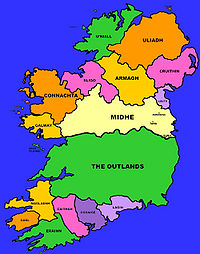Eíre
From GURPSworld Wiki
- Much of the information in this article may be dated or obsolete. Please read Return to Eíre for an update on recent events.
Eíre is an alternate medieval Ireland where Christianity never took root on the island. Religious persecution on the continent has resulted in the immigration of pagan refugees who seek asylum in Eíre. In addition to GURPS Basic Set 4th edition, the rulebooks for the campaign are GURPS Magic 4th edition and GURPS Fantasy 4th edition. The third-edition sourcebook GURPS Celtic Myth is used for information and background.
Introduction
The islands of Eíre and Prydaín put centuries of warfare behind them in the year 2387 KE (453 CE), when Niall, High King at Tara, and Arthur, King of Prydaín, agreed to an alliance against the Holy Empire, militant religious invaders from the Continent. The zealots of the Holy Empire had conquered the Continent and sought to expand their territory, converting by the sword those who followed the old traditions. Many were burned, hung, beheaded, and otherwise violated when they refused to recant their abiding faith. Agreeing to combat the evil for the good of all the people, Níall and Arthur merged their vast armies and drove away the armies of the Holy Empire.
This history is taught and spoken often, and songs are sung about the glory of the battle, the tragic death of Níall. A cycle of myths exists even for the King of Prydaín, whose adventures are often more requested of bards than the tales of Finn or the travails of Cúchulainn, though present-day Eíre and Prydaín hardly resemble their past states. The last of the High Kings of Tara left the throne nearly a hundred years ago, and the King of Prydaín is no longer a trusted ally.
The Invasion of Prydaín
In the year 3000 KE (1066 CE) a brilliant star was seen in the skies in the early months of that year, and all agreed it foretold something eventful. Duke William of Normandie soon provided the proper event when his armies invaded Prydaín and overtook the kingdom. Prydaín’s growing population of religious zealots wasted no time in persecuting those who held to the old beliefs. The pagans of Prydaín were driven from their homes, many of them fleeing to Eíre for safety.
Contemporary Eíre
The year is 3098 KE (1164 CE). Since the 6th century, the destructive storm of militant religion across the continent has driven many a strange and magical creature onto the shores of Eíre and Prydaín; the invasion of Prydaín drove even more onto Eírean shores. The faerie population has in the intervening years more than tripled, and creatures previously unknown to the island have taken up permanent residence. The vast majority inhabit an area that spans from the eastern to the western shore, and divides the island into northern and southern kingdoms. This area, known as the Outlands, is under no human law. Instead, various areas are governed by whatever creatures dominate or otherwise control the area. This anarchic state is perhaps best for these beings, as any attempt to establish political boundaries within the Outlands would lead to eternal warfare, much of it magical in nature.
Dates and Time in Eíre
Most of Eire, along with Prydain and the Continent, uses the [[1]]Julian calendar. Roman names for months are maintained, though traditional Celtic festivals and holidays are celebrated rather than pagan Roman tradition.
The year in Eire is based on the history of the High Kings. Slaíne, son of Dela, was the first of the High Kings. He came ashore at Loch Garman, invading the ancient island with five thousand of his Fir Bolg warriors. Slaíne and his four brothers divided the land among themselves, and each ruled a kingdom. The brothers elected Slaíne to be the High King over them. This took place in the year 1934 BCE, which is taken as "Year Zero" for Eireann historic calendar. Because the reckoning is based on the reign of kings, it is referred to as King’s Era, and abbreviated KE.
Example: One of the most significant years in recent history is the fall of Prydaín to the third invasion of armies from the continent. This took place in the year 1066 CE (and corresponds to the Norman invasion of England), which is the year 3000 KE.
Keeping hourly time in GURPS Eíre is another matter. The era and technology level are pre-clockwork, so the most common method of telling time is by gauging the position of the sun in the sky. Most villages have sundials located in the village square, and many towns have large gnomons in the city center. Many castles and some temples have water clocks, large mechanisms which use water power to operate. These devices are the most accurate time keeping devices known.
Additional Information
Player Characters
Update
Much of the above information about Eíre may be dated or obsolete. Please read Return to Eíre for an update on recent events.
